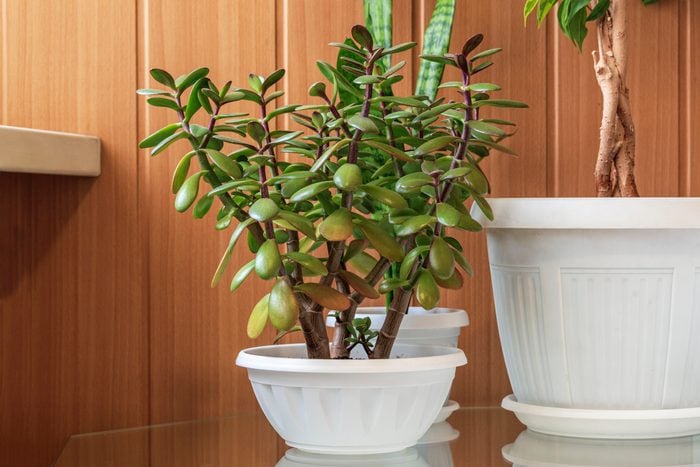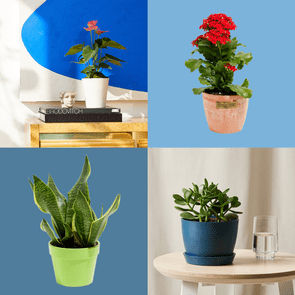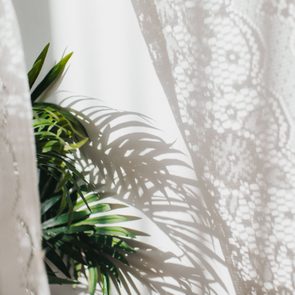How to Care for a Jade Plant
Updated: Mar. 11, 2024

Jade plant care is super simple, making this beauty the ideal beginner plant
We get it: Not everyone has the magic touch when it comes to houseplants. If you struggle to keep yours alive but still want greenery in your space, look no further than the jade plant. Also known as the money plant, this succulent symbolizes luck and prosperity. Jade plant care is simple—even if your thumbs aren’t particularly green. For new plant parents, this no-fuss houseplant is a wonderful place to start. But these succulents aren’t just hardy; with light-green, oval-shaped leaves and wooden stems, they’re also pretty additions to any decor.
“Jade plants are easy to care for, can thrive in most conditions and are known to improve indoor air quality and improve well-being, among other benefits that plants in general typically have,” says Alfred Palomares, vice president of merchandising and resident plant dad at 1-800-Flowers.
Curious about other indoor plants and types of succulents to add to your collection? First, consider how hands-on you want to be. If you’re more of a hands-off plant parent, check out these low-maintenance indoor plants. Make sure there is ample light where you plan to place them, or choose one of these low-light indoor plants. Because if you don’t provide a houseplant with the proper conditions, you may need to learn how to revive a dead plant. Don’t feel like venturing to the nursery? No problem. You can buy plants online directly from the comfort of your sofa.
Keep reading to find out everything you need to know about how to care for a jade plant.
| Botanical name | Crassula ovata |
| Height | 3 to 6 feet |
| Sun exposure | Full sun |
| Soil type | Well-draining |
| Toxicity | Toxic to pets |
| Soil pH | Neutral, acidic |
Where to put a jade plant
Jade plant care is easy, as long as you give this houseplant the conditions it craves. In fact, well-maintained and well cared for jade plants can last for decades. Start by catering to its lighting needs: Place this succulent in a sunny area of the home—jade plants need a lot of sunlight to thrive.
“Jade plants need direct sunlight or very bright indirect light, so keep it in a sunny spot in your home, like a south-facing window,” says Lindsay Pangborn, a gardening expert at Bloomscape. Insufficient light will affect your jade plant’s growth. “Placement in medium or low light will cause growth to slow, older leaves to fall off and new growth to become ‘stretched’ and leggy,” she says.
Give it the sunlight it needs, and you’ll have no problem with jade plant care. These easygoing plants do well in most indoor environments. “Just like cacti, jade plants will thrive best in climates that are dry and are 55 degrees or higher at any given time,” explains Palomares.
Because they’re so unfussy, jade plants make decorating simple. “They are a bit more adaptable to temperature and humidity shifts than some other common houseplants, giving more flexibility in where they can be placed around the house,” Pangborn says.
Finally, when deciding where to put your jade plant, consider your furry friends. The jade plant is toxic for dogs and cats, so either keep yours out of reach of your four-legged housemates, or pick a different plant.
Jade plant care
So, how exactly do you care for these succulents? Once you’ve taken sunlight into account, focus on the soil, water and fertilizer.
Soil
When determining how to care for a jade plant, know that the type of soil is key. “A soil that is intended for cacti or succulents is perfect for a jade plant, due to its drainage,” says Palomares. The best jade plant soil drains well. That’s important because it helps prevent roots from sitting in water, which can lead to root rot.
Water
Jade plants require full sunlight, and this affects the amount of water they need. According to Palomares, the soil will dry out more quickly the longer the plant stays in the sun.
According to Pangborn, a good rule of thumb when it comes to plant watering is to let the soil dry out before giving it another drink. Your jade plant may give you signs when it’s thirsty. “You’ll notice the leaves may get a bit wrinkled when it’s ready for a drink,” she says.
Wondering how often to water a jade plant? Well, that depends on the time of year and how much sun it receives. “Jade plants should be watered roughly every week, and this may increase in the warmer spring and summer months and decrease during fall and winter,” says Megan McDugald, manager of horticulture at Gaylord Opryland Center. Palomares says that in winter, you may need to water only once a month.
Fertilizer
Another component of jade plant care is fertilizer. Succulents can use a boost, especially during the growing season. According to McDugald, most jade plants will already be fertilized when you purchase them.
“After four months, apply a 14-14-14 granular fertilizer to the base of the plant to keep it fresh and thriving,” she says. Of course, if you know how to compost, you can make your own natural fertilizer for your plants.
Types of jade plants
Ready to bring home your new jade plant? Before you shop, know that there’s more than one type. Here are a few that’ll breathe life into your home.
-
Gollum Jade: “The Gollum Jade is a variety with unique foliage that is tubular in shape, with leaves that almost look like protruding fingers,” says McDugald.
-
Senecio Jacobsenii Trailing Jade: This jade is perfect to place in a hanging basket. Consider these indoor hanging plants too.
-
Sunset Jade Plant: This one gets its name for the reddish-magenta hue that appears on the outer edge of the leaves in summer.
Common pests
Common houseplant pests can plague even the hardiest of plants. “Jade plants, just like any succulent or houseplant, can be prone to pests such as mealybugs, aphids and mites,” explains Palomares. “Whether the plant was living outside and wasn’t dusted before being moved indoors, or its health is on a downturn, emitting hormones that attract bugs, pests are common but can be managed.”
One of the easiest ways to minimize pests is to dust the leaves often, which also keeps the plant healthy. “Dust this plant’s round leaves regularly, which allows for more efficient sunlight absorption and photosynthesis, which is key for healthy plants,” says Pangborn. “This will also help you spot any early-stage insect infestations.”
How to propagate jade plants
If you want more jade plants in your home but don’t want to spend a whole lot of money, learn how to propagate a jade plant. Armed with that knowledge, you can get a bunch of jade plant babies from the single plant you purchased. “Jade plants are very easy to propagate for those who want to share their plants with others or multiply their own growing collection,” says McDugald.
Jade plant propagation is easy and straightforward. The simplest way to do it is to use cuttings.
“Cut a stem that is about three inches long from a matured plant,” says Palomares. “The cutting should then sit for days—possibly a week—in a warm, dry location so that the end of the cutting can scab over. Once the cutting has scabbed over, dip it in a rooting hormone and plant the cut end of the stem in a container with a mix of half soil and half vermiculite.”
Keep the potting mixture damp (but not soggy!) while the roots grow. Once it has roots, you can care for the jade plant as you typically would, says Palomares.
Want to add more houseplants to your space? Consider these tall plants, air-purifying plants and medicinal herbs. Or if you can’t decide, sign up for plant subscription boxes that’ll help you turn your lifeless home into a living jungle.
Get Reader’s Digest’s Read Up newsletter for more helpful tips, tech, travel, humor, cleaning and fun facts all week long.
Sources:
- Alfred Palomares, vice president of merchandising and resident plant dad at 1-800-Flowers.com
- Lindsay Pangborn, gardening expert at Bloomscape
- Megan McDugald, manager of horticulture at Gaylord Opryland Resort & Convention Center



